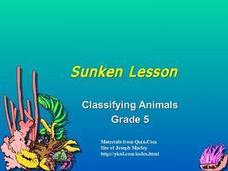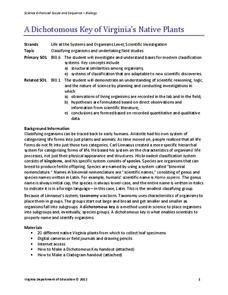Phylum Teacher Resources
Find Phylum lesson plans and worksheets
Showing 393 resources
Curated OER
Biodiversity
In this biodiversity worksheet, students sort and classify animals by their observable features using a dichotomous key. Students then respond to questions about complete and incomplete metamorphosis.
Curated OER
Cool Corals
Learners research questions pertaining to ecology and biology of shallow and deep water corals. In this investigative lesson student get into groups and design questions that will expand their knowledge of corals.
Curated OER
Sunken Lesson: Classifying Animals
This PowerPoint features vocabulary and key concepts related to animal classification. Information about levels of classification, traits common to vertebrates and invertebrates, and a description of metamorphosis are included. The text...
Curated OER
Classification/Taxonomy/Statistics Review
"Does King Phillip Cry Over Flimsy Grass Stems?" You might not answer that question with this exhaustive worksheet, but your biology class will get the full scoop on the hierarchy of biological classification with this resource. It...
Casimir Middle School
Biological Classification Worksheet
Classify living things with a set of worksheets that has pupils sorting and indentifying living and non-living things. Learners use the worksheets as a basis for finding their answers.
Curated OER
7th Science Quiz
This seventh grade life science quiz has a professional appearance and well-written multiple-choice questions. However, it seems to cover too broad a variety of biology topics for only 15 questions to fully assess. There is one question...
Curated OER
Deep Gardens
Marine biology beginners read about the 2005 Florida Coast Deep Corals expedition, research phylum Cnidaria, and then report on a specific coral deep-sea coral group. There is an abundance of background information and internet resources...
Curated OER
Arthropods
This PowerPoint leads students through the details of the Phylum Arthropoda and the subphyla that have various distinctive characteristics. There are pictures to illustrate the individual classes and slides of information.
Curated OER
Cnidarian Reproduction and Platyhelminthes
Opening with one slide on cnidarian reproduction, this PowerPoint is more focused on phylum platyhelminthes. It touches on flatworm structure, feeding, body systems, and reproduction. Simple, yet informative, this resource will support...
Curated OER
Protists
With this collection of slides, future biologists get to view photographs of protozoans from different phyla. Interspersed with the photos are bullet-style notes listing characteristics of each group. Unfortunately, most of the pictures...
Scholastic
Study Jams! Vertebrates
Your back will be covered when you use this presentation to introduce beginning biologists to phylum chordata, the vertebrates. Five classes are defined: fish, amphibians, reptiles, birds, and mammals throughout the eight vibrant slides....
Curated OER
Invertebrate Classification
Students discuss the recent disovery of the "furry lobster" to peak interest in the animal kingdom. They classify various speciments using invertebrate dichotomous keys, identifying major animal phyla and classes. Thy the complete the...
Curated OER
Vertebrates
Students identify and describe five main groups of the Phylum Chordata. They discover that the Phylum Chordata is the vertebrates. Students identify the main difference between invertebrates and vertebrates. They read passages about...
Curated OER
Structures and Behaviors of Planarians
Students investigate planaria of the phylum platyhelminthes. They use DigiScope technology to observe and describe the structure and movements of planarians.
Curated OER
Arthropod Coloring
In this arthropod worksheet, students compare and contrast the different animals found in the Phylum Arthropoda: insects, arachnids, and crustaceans. Students complete 8 fill in the blank statements and color illustrations.
Curated OER
Kingdom Animalia ~ A Look at the Five Major Classes
Biological taxonomy masters examine the five main classes under phylum chordata. Pupils compare and contrast the identifying characteristics of the various organisms. They explain why taxonomy is important in classifying organisms. You...
Virginia Department of Education
A Dichotomous Key of Virginia’s Native Plants
Can your class correctly classify plant species? Individuals explore native plants of the local environment and correctly classify them into their respective categories. They investigate differences in the plants and discuss similarities...
Biology Junction
Segmented Worms - The Earthworm
In this biology worksheet, students color and label the different parts of an earth worm. They complete 41 short answers and fill in the blank questions about earthworms.
Curated OER
Invertebrate Chordates
Most chordates are easy to identify because of the specific classification criteria of their phylum. But what about tunicates? Young scientists read a short explanation about why tunicates, or sea squirts, are considered to be members of...
Curated OER
Classification of an Invertebrate: Sponge
Students investigate the invertebrate sponge. In this invertebrates lesson plan, students observe the sponge, Grantia, using a dissecting microscope. Students answer questions about their observations and view six other invertebrates....
Curated OER
Sponges - A Coloring Worksheet
In this sponges worksheet, students read the information about sponges. Students answer the provided questions about the reading passage. Students color the illustration at the bottom of the page.
Curated OER
Observation of a Living Earthworm
Sixth graders examine earthworms and their parts. In this earthworm lesson students complete a lab worksheet on the earthworm and test its response to certain factors.
Curated OER
Classification of Living Things
In this biology worksheet, students identify and locate various vocabulary terms relating to the classification of living things. There are 28 biology terms located in the word search.
Curated OER
Levels of Classification
Students use diagrams to compare structural differences that taxonomists use to classify animals. In this classification lesson plan, students compare structures of different species from given diagrams. In one diagram they identify the...
Other popular searches
- Phylum Taxonomy
- Animal Phylum
- Phylum Chordata Concept Map
- Phylum Arthropod
- Invertebrate Phylum
- Kingdom Phylum Species Genus
- Phylum Annelid
- Phylum Annelida
- Kingdom Phylum
- Phylum Arthropoda
- Kingdom, Phylum
- Animal Phylum Matching

























